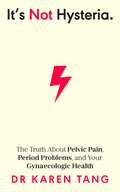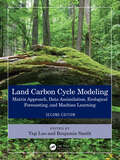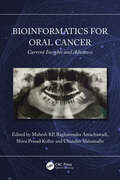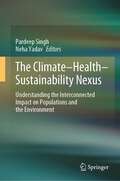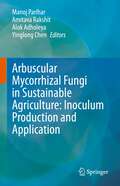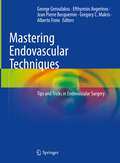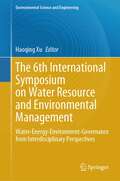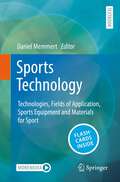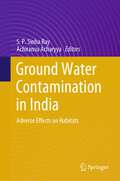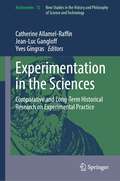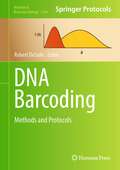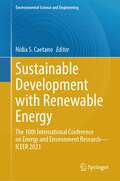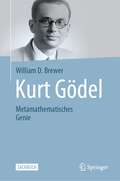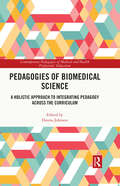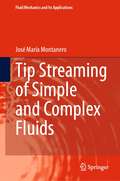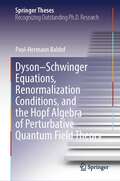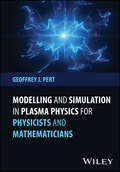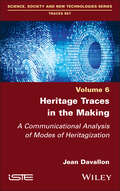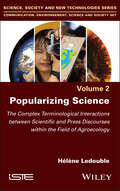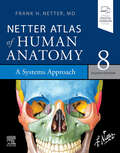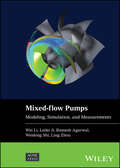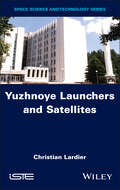- Table View
- List View
It’s Not Hysteria: The Truth About Pelvic Pain, Period Problems, and Your Gynaecologic Health
by Dr Karen TangDid you know that up to 90% of women experience menstrual abnormalities or pelvic problems in their lifetime? Yet these issues are overwhelmingly misunderstood, misdiagnosed, or dismissed. Conditions such as PCOS, endometriosis, fibroids, ovarian cysts, PMDD, or pelvic floor dysfunction, don’t receive the stream of funding for research and new treatments that other conditions do, despite affecting up to half the population.It's Not Hysteria shares critical knowledge that anyone impacted by these conditions desperately needs. Covering everything from the anatomy and reproductive health basics you wish you learned at school, to issues such as abnormal periods, PCOS, endometriosis, and fibroids, to more complex aspects of gynaecologic care like fertility, sexual health, and hysterectomies. Dr Tang's accessible advice empowers readers to take action and advocate for themselves with healthcare professionals.At a turbulent time when global health, reproductive, and human rights are under siege, Dr Tang is determined to revolutionise how gynaecologic health and pelvic pain are treated by the medical community. This book will be part of the fight for the healthcare all people with uteruses deserve - healthcare that is intersectional, gender-affirming, validating and hopeful.
Land Carbon Cycle Modeling: Matrix Approach, Data Assimilation, Ecological Forecasting, and Machine Learning
by Yiqi LuoCarbon moves through the atmosphere, through the oceans, onto land, and into ecosystems. This cycling has a large effect on climate – changing geographic patterns of rainfall and the frequency of extreme weather – and is altered as the use of fossil fuels adds carbon to the cycle. The dynamics of this global carbon cycling are largely predicted over broad spatial scales and long periods of time by Earth system models. This book addresses the crucial question of how to assess, evaluate, and estimate the potential impact of the additional carbon to the land carbon cycle. The contributors describe a set of new approaches to land carbon cycle modeling for better exploring ecological questions regarding changes in carbon cycling; employing data assimilation techniques for model improvement; doing real- or near-time ecological forecasting for decision support; and combining newly available machine learning techniques with process-based models to improve prediction of the land carbon cycle under climate change. This new edition includes seven new chapters: machine learning and its applications to carbon cycle research (five chapters); principles underlying carbon dioxide removal from the atmosphere, contemporary active research and management issues (one chapter); and community infrastructure for ecological forecasting (one chapter). Key Features Helps readers understand, implement, and criticize land carbon cycle models Offers a new theoretical framework to understand transient dynamics of the land carbon cycle Describes a suite of modeling skills – matrix approach to represent land carbon, nitrogen, and phosphorus cycles; data assimilation and machine learning to improve parameterization; and workflow systems to facilitate ecological forecasting Introduces a new set of techniques, such as semi-analytic spin-up (SASU), unified diagnostic system with a 1-3-5 scheme, traceability analysis, and benchmark analysis, and PROcess-guided machine learning and DAta-driven modeling (PRODA) for model evaluation and improvement Reorganized from the first edition with seven new chapters added Strives to balance theoretical considerations, technical details, and applications of ecosystem modeling for research, assessment, and crucial decision-making
Land Carbon Cycle Modeling: Matrix Approach, Data Assimilation, Ecological Forecasting, and Machine Learning
Carbon moves through the atmosphere, through the oceans, onto land, and into ecosystems. This cycling has a large effect on climate – changing geographic patterns of rainfall and the frequency of extreme weather – and is altered as the use of fossil fuels adds carbon to the cycle. The dynamics of this global carbon cycling are largely predicted over broad spatial scales and long periods of time by Earth system models. This book addresses the crucial question of how to assess, evaluate, and estimate the potential impact of the additional carbon to the land carbon cycle. The contributors describe a set of new approaches to land carbon cycle modeling for better exploring ecological questions regarding changes in carbon cycling; employing data assimilation techniques for model improvement; doing real- or near-time ecological forecasting for decision support; and combining newly available machine learning techniques with process-based models to improve prediction of the land carbon cycle under climate change. This new edition includes seven new chapters: machine learning and its applications to carbon cycle research (five chapters); principles underlying carbon dioxide removal from the atmosphere, contemporary active research and management issues (one chapter); and community infrastructure for ecological forecasting (one chapter). Key Features Helps readers understand, implement, and criticize land carbon cycle models Offers a new theoretical framework to understand transient dynamics of the land carbon cycle Describes a suite of modeling skills – matrix approach to represent land carbon, nitrogen, and phosphorus cycles; data assimilation and machine learning to improve parameterization; and workflow systems to facilitate ecological forecasting Introduces a new set of techniques, such as semi-analytic spin-up (SASU), unified diagnostic system with a 1-3-5 scheme, traceability analysis, and benchmark analysis, and PROcess-guided machine learning and DAta-driven modeling (PRODA) for model evaluation and improvement Reorganized from the first edition with seven new chapters added Strives to balance theoretical considerations, technical details, and applications of ecosystem modeling for research, assessment, and crucial decision-making
Bioinformatics for Oral Cancer: Current Insights and Advances
by Raghavendra Amachawadi Shiva Prasad Kollur Chandan Shivamallu Mahesh KpAmid the rising global concern of oral cancer, this book provides a compelling exploration of the intricate oral cavity, focused on shedding light on early diagnosis and addressing outdated paradigms, it delves into the persistent challenges of oral premalignant lesions. Tailored for both beginners and researchers, its six chapters encompass the spectrum of genome sequencing, diagnostic biomarkers, gene expression, and more. Discover a fusion of basic and clinical sciences, aiming to invigorate the study of bioinformatics and oral cancer, and ultimately improve survival rates.Bioinformatics for Oral Cancer: Current Insights and Advances serves as a comprehensive guide, offering a deep dive into the multifaceted landscape of oral cancer research and bioinformatics. Within its pages, readers will uncover a wealth of knowledge, starting with foundational chapters introducing bioinformatics and establishing the backdrop of oral cancer. The book then progresses into the realm of diagnostic biomarkers, revealing cutting-edge methodologies for their identification in the context of oral cancer. The book’s keen focus extends to gene expression profiles and the intricacies of gene sequencing in the context of oral cancer progression. By systematically unravelling these critical aspects, the book bridges the gap between basic and clinical sciences, equipping readers with a holistic understanding of bioinformatics’ pivotal role in enhancing our grasp of oral cancer’s complexities.By deciphering the enigmatic landscape of oral premalignant lesions, the book equips clinicians and researchers with tools to predict malignant potentials. Its meticulous exploration of gene expression profiles and sequencing promises to reshape early detection strategies, propelling the field towards improved diagnosis and treatment outcomes.
Bioinformatics for Oral Cancer: Current Insights and Advances
Amid the rising global concern of oral cancer, this book provides a compelling exploration of the intricate oral cavity, focused on shedding light on early diagnosis and addressing outdated paradigms, it delves into the persistent challenges of oral premalignant lesions. Tailored for both beginners and researchers, its six chapters encompass the spectrum of genome sequencing, diagnostic biomarkers, gene expression, and more. Discover a fusion of basic and clinical sciences, aiming to invigorate the study of bioinformatics and oral cancer, and ultimately improve survival rates.Bioinformatics for Oral Cancer: Current Insights and Advances serves as a comprehensive guide, offering a deep dive into the multifaceted landscape of oral cancer research and bioinformatics. Within its pages, readers will uncover a wealth of knowledge, starting with foundational chapters introducing bioinformatics and establishing the backdrop of oral cancer. The book then progresses into the realm of diagnostic biomarkers, revealing cutting-edge methodologies for their identification in the context of oral cancer. The book’s keen focus extends to gene expression profiles and the intricacies of gene sequencing in the context of oral cancer progression. By systematically unravelling these critical aspects, the book bridges the gap between basic and clinical sciences, equipping readers with a holistic understanding of bioinformatics’ pivotal role in enhancing our grasp of oral cancer’s complexities.By deciphering the enigmatic landscape of oral premalignant lesions, the book equips clinicians and researchers with tools to predict malignant potentials. Its meticulous exploration of gene expression profiles and sequencing promises to reshape early detection strategies, propelling the field towards improved diagnosis and treatment outcomes.
The Climate-Health-Sustainability Nexus: Understanding the Interconnected Impact on Populations and the Environment
by Neha Yadav Pardeep SinghIn a compelling scholarly journey, this book unfolds the intricate narratives of human progress and its environmental repercussions catalyzed by the Industrial Revolution. It thoughtfully contrasts the exploitative environmental ideologies stemming from colonization and industrialization against the profound yet often marginalized indigenous ecological philosophies, urging a pivotal shift in environmental stewardship. The narrative meticulously traces the arc of scientific discovery and environmental policy evolution, from Eunice Foote’s groundbreaking hypothesis on the greenhouse effect to the landmark achievements of the Paris Agreement, encapsulating over a century of environmental activism and scholarly debate. The discourse extends beyond traditional environmental concerns, exploring the intersection of climate change with public health, food security, and gender disparities, underscoring the urgency of sustainable agricultural practices and the pivotal role of women in food systems. It introduces the transformative potential of digital health innovations and renewable energy technologies as crucial tools in climate mitigation, highlighting the need for an integrated socio-technical governance model that includes community resilience and biopsychosocial health. The book critically addresses the dynamics of climate finance, advocating for inclusive green growth through strategic renewable energy investments, and revisits the ‘Tragedy of the Commons’ to challenge conventional views on communal resource management. It advocates for a justice-oriented approach to tackling the multifaceted environmental, social, and economic challenges, with a particular lens on the adverse impacts borne by marginalized communities in the Global South. Furthermore, it explores the untapped potential of wild genetic resources in bolstering food security. It aligns with the United Nations’ Sustainable Development Goals, advocating for integrating Indigenous wisdom into urban development strategies. This book is a call to action, serving as a comprehensive scholarly examination that addresses the multifaceted challenges of climate change, health, and sustainability and champions a collective approach towards forging a sustainable and equitable future.
Arbuscular Mycorrhizal Fungi in Sustainable Agriculture: Inoculum Production and Application
by Amitava Rakshit Manoj Parihar Alok Adholeya Yinglong ChenThis 2-volume book is an up-to-date overview of current progress in Arbuscular Mycorrhizal Fungal (AMF) technique development, inoculum production and its quality regulations, application in agriculture, horticulture, agroforestry, and other ecosystems, along with nutrient management for sustainable food production. It contains the current advancement in basic and molecular techniques, challenges, opportunities, and determinates of various AMF production methods and major tools and techniques for their field application. Production and development of AMF is rapidly evolving and requires a multidisciplinary approach with up-to-date knowledge to broaden and strengthen the perspective of researchers involved in this domain. The volumes offer new insight and cutting-edge information for novices and experts such as students, academicians, researchers, environmentalists, industrialists, and others interested in mycorrhiza. The first volume covers some basic isolation techniques, enumeration,and molecular studies with recent advances in various in-vitro and in-vivo production technologies, regulatory issues, and application methodologies for field inoculation. It also discusses AMF application in various agroecosystems for sustainable agricultural production and a healthier planet.
Mastering Endovascular Techniques: Tips and Tricks in Endovascular Surgery
by George Geroulakos Efthymios Avgerinos Jean Pierre Becquemin Gregory C. Makris Alberto FroioThis book provides a detailed practically applicable guide to using the latest endovascular techniques. Chapters feature detailed step-by-step instructions on how to perform procedures relevant for instances of disorders including cerebrovascular disease, splachnic arteries, and aortic aneurysms. Multiple choice questions are provided throughout to enable the reader to identify the points covered. Mastering Endovascular Techniques: Tips and Tricks in Endovascular Surgery describes the latest endovascular methodologies and features detailed insight on how to apply these techniques into day-to-day clinical practice.
The 6th International Symposium on Water Resource and Environmental Management: Water-Energy-Environment-Governance from Interdisciplinary Perspectives (Environmental Science and Engineering)
by Haoqing XuThis book is designed to be the introductory work in the Water-Energy-Environment-Governance from Interdisciplinary Perspectives Series and provides an in-depth look at sustainable development and management in the water sector across. The water-energy-environment nexus (WEEN) represents important interstate connections of water, energy, and the environment. Present day water and energy systems are interdependent. Water is used in all phases of energy production and electricity generation. Energy is required to extract, convey, and deliver water of appropriate quality for diverse human uses and then again to treat waste waters prior to their return to the environment. Security in water, energy, and the environment is associated with human, economic, and environmental sustainability. This interweaving is strengthening under aggregating natural resource scarcity and climate change. This book includes selected papers from the 6th International Symposium on Water Resource and EnvironmentalManagement (WREM 2023) and consists of themes pertaining to water resource and environmental management. It provides readers with comprehensive information, and formulation of solutions leading to a set of Water-Energy-Environment-Governance from Interdisciplinary Perspectives through our forum and the publication of your research. As a reference, it is of interest to students, scientists, engineers, government officials, and water resource managers.
Sports Technology: Technologies, Fields of Application, Sports Equipment and Materials for Sport
by Daniel MemmertSports technological tools and innovations are gaining increasing significance in amateur, elite, and health-related sports. Sports technology refers to the application of scientific and technical principles, along with innovative technologies, to enhance athletic performance, increase safety, and consequently optimize the overall sporting experience. This involves the design, development, and utilization of equipment, devices, systems, and software specifically tailored for athletic purposes.This textbook aims to encompass the broad diversity of sports technology by featuring contributions from over 30 authors within their respective specialized fields, summarizing the latest insights concisely. The work is structured into five main sections: Data Acquisition Systems, Sports Equipment and Materials, Diagnostics, Evaluation and Communication, and Selected Fields of Application. Students with a connection to sports science gain a comprehensive understanding of sports technology supported by a carefully designed concept that facilitates easy delivery of learning content. Digital learning cards (SN Flashcards) reinforce the learning effect and ensure optimal exam preparation. For advanced learners, in-depth discussions on topics such as tracking data, digital training assistants, sports floor characteristics, virtual reality in sports, smartphone apps, and diagnostic tools offer additional value.
Ground Water Contamination in India: Adverse Effects on Habitats
by Achiransu Acharyya S. P. Sinha RayThis book examines contamination in groundwater. Groundwater is a lifeline for most countries of the world. 90% of the Indian population rely on groundwater-based drinking water as safe mode of water supply. The terminology contamination in groundwater along with adverse effect on habitats, suggests the impact of such contamination in not only for drinking water, but also for agricultural irrigation. In addition, polluted groundwater causes adverse health hazards including social aspects that affect wider communities. Impacts on plant life also are equally threatening. This book provides readers with an insight into groundwater contamination in India. The economic loss associated with this devastating phenomenon is also studied in detail, which has a direct bearing to the country's GDP.
Experimentation in the Sciences: Comparative and Long-Term Historical Research on Experimental Practice (Archimedes #72)
by Yves Gingras Catherine Allamel-Raffin Jean-Luc GangloffThis book takes a novel approach by highlighting comparative and long-term historical perspectives on experimental practice. The juxtaposition of accounts of natural, social, and medical experimentation is very enlightening, especially because the authors put the emphasis on the different kinds of objects of experimentation (physical matter, chemical reagents, social groups, organizations, sick individuals, archeological remains) and demonstrate how much the kinds of objects matter for the practice of experimentation, its methods, tools, and methodologies. Taken together, the chapters raise several fascinating questions for further study: What do these different approaches have in common? Why do we call them “experimentation”? What are the intersections among the fields and their developments? The volume engages philosophical approaches that are not well known to Anglophone readers (Bachelard, Bergson, Bernard, Canguilhem, among others) and brings to attention a wealth of Francophone secondary literature on past and present scientific experimentation. The collection fills a yawning gap in science, science studies, and philosophy of science teaching, making it particularly valuable philosophers and historians of science in all subfields.
DNA Barcoding: Methods and Protocols (Methods in Molecular Biology #2744)
by Robert DeSalleThis volume covers the latest advancements and methods used to study DNA barcoding. The chapters in this book are organized into six parts: theory, DNA manipulation, specialized barcoding methods, analysis of DNA barcodes, completing a successful DNA barcode project, and barcoding as citizen science. Part One looks at several theoretical issues in DNA barcoding concerned with DNA barcodes that can and should be used. Part Two discusses protocols for processing samples into DNA barcodes, including DNA isolation, sequencing and managing samples, and the resulting DNA barcodes. Part Three explores the next generation of DNA barcoding such as FRET-based detection, dual nanopore detection, skimming, and closed-tube methods. Part Four addresses programs and websites that handle DNA barcoding data, and includes character-based approaches, barcode gap methods, integrated approaches, and Barcode of Life Database. Part Five offers protocols for producing a successfulDNA barcoding project including plant and animal examples and protocols for generating a DNA Barcode Reference Library. Lastly, Part Six talks about several novel protocols for setting up an educational program using DNA barcodes. Written in the highly successful Methods in Molecular Biology series format, chapters include introductions to their respective topics, lists of the necessary materials and reagents, step-by-step, readily reproducible laboratory protocols, and tips on troubleshooting and avoiding known pitfalls.Cutting-edge and thorough, DNA Barcoding: Methods and Protocols encompasses a wide range of techniques and will be a useful reference tool for both scientist and student.
Sustainable Development with Renewable Energy: The 10th International Conference on Energy and Environment Research—ICEER 2023 (Environmental Science and Engineering)
by Nídia S. CaetanoThis proceedings book contains the full papers of the 10th edition of the International Conference on Energy and Environment Research, ICEER 2023, that took place in Madrid, Spain during October 7–9, 2023. ICEER 2023 is a joint organization of the School of Engineering (ISEP) of the Polytechnic of Porto (P.Porto) and the SCIEI, with collaboration of the Dipartimento di Ingegneria of the Università degli studi "Roma Tre", CIETI and LEPABE research groups. This book includes all the well prepared full papers presented at ICEER 2023.
Kurt Gödel: Metamathematisches Genie
by William D. BrewerZu seinen Lebzeiten war Kurt Gödel außerhalb der Fachwelt der Mathematiker, Philosophen und theoretischen Physiker kaum bekannt. Zu Beginn seiner Karriere schuf er beeindruckende Arbeiten zur Vollständigkeit und Beweisbarkeit formaler logischer Systeme, die zu seiner Dissertation und seiner Habilitations-schrift wurden und ihn unter Fachleuten weltberühmt machten. Seine Unvoll-ständigkeitssätze läuteten das Ende der formal-logischen Programme der Logizisten (Russell et al.) und der Formalisten (Hilbert et al.) ein. Später erzielte er auch signifikante Ergebnisse in der Mengenlehre. Nach seiner Emigration in die USA (Princeton), widmete er sich mehr der Philosophie, dem Leitmotiv seines Lebens, und er fand auch eine einzigartige Lösung zu Einsteins Feld-gleichungen der Gravitation, sein “Gödel-Universum“. Dieses Buch beschreibt sowohl den Gödel, der ein genialer Wissenschaftler war, und der gewagte und neuartige Hypothesen zu den Fundamenten der Mathe-matik und Physik hervorbrachte, ‒ als auch den Gödel, der ein perfekter Rationalist war, aber sein Alltagsleben nur mit Mühe meistern konnte und zeitlebens unter Depressionen, Angstneurosen und Hypochondrie litt. Ein Leben voller Paradoxen, in dem er trotz all seiner psychischen Probleme Beachtliches leistete und zu einem Vorbild für viele jüngere Wissenschaftler wurde. Das Buch liefert den Kontext zu seinen Errungenschaften, die ein verblüffend breites Spektrum intellektueller Unternehmungen darstellen, und zu seiner zunehmenden Geisteskrankheit; und es zeigt, wie er eine lange und erfolgreiche Karriere mit Hilfe seiner loyalen Ehefrau Adele und einigen seiner Freunde durchlaufen konnte. Dies ist eine faszinierende Geschichte der wissen-schaftlichen Genialität und der menschlichen Natur.
Pedagogies of Biomedical Science: A Holistic Approach to Integrating Pedagogy Across the Curriculum (Contemporary Pedagogies of Medical and Health Professions’ Education)
by Donna JohnsonThis book confronts the continually evolving nature of biomedical science education by providing a robust account of learning pedagogies and best practice for scholars and researchers in the field.Rather than considering subdisciplines of biomedical science education separately, the volume takes a holistic approach and considers the complexities of teaching biomedical science as a whole, providing a nuanced overview of how a particular practice fits in such a course overall, as well as providing support for development within the reader’s own subdiscipline. Ultimately, this holistic approach allows for expansive discussion of relevant pedagogical approaches that will directly inform innovations in the contemporary teaching of biomedical science education.Novel in approach and underpinned by the latest in research innovations, this book will appeal to scholars, researchers and postgraduate students in the fields of medical education, higher education, and curriculum studies. Policy makers involved with health education and promotion as well as educational research will also benefit from the volume.
Pedagogies of Biomedical Science: A Holistic Approach to Integrating Pedagogy Across the Curriculum (Contemporary Pedagogies of Medical and Health Professions’ Education)
This book confronts the continually evolving nature of biomedical science education by providing a robust account of learning pedagogies and best practice for scholars and researchers in the field.Rather than considering subdisciplines of biomedical science education separately, the volume takes a holistic approach and considers the complexities of teaching biomedical science as a whole, providing a nuanced overview of how a particular practice fits in such a course overall, as well as providing support for development within the reader’s own subdiscipline. Ultimately, this holistic approach allows for expansive discussion of relevant pedagogical approaches that will directly inform innovations in the contemporary teaching of biomedical science education.Novel in approach and underpinned by the latest in research innovations, this book will appeal to scholars, researchers and postgraduate students in the fields of medical education, higher education, and curriculum studies. Policy makers involved with health education and promotion as well as educational research will also benefit from the volume.
Tip Streaming of Simple and Complex Fluids (Fluid Mechanics and Its Applications #137)
by José María MontaneroThis book comprehensively describes the tip streaming in simple fluids and those containing surfactants and polymeric molecules. It summarizes the theoretical models and approximations commonly adopted to analyze this phenomenon. It provides relevant experimental results and presents the scaling laws for rationalizing those results. The stability of the flows leading to tip streaming is analyzed theoretically and experimentally. Attention is paid to the effects of surfactant monolayers and viscoelasticity, including solutocapillarity, interfacial elasticity, surface viscosity, and extensional thickening caused by the polymer coil-stretch transition.It also offers an overall perspective of the numerous technological applications of the tip-streaming phenomenon. Remarkable examples are the production of microemulsions and microencapsulation of active agents for the food and pharmacy industries, the atomization of charged liquids for analytical chemistry, and the ejection of ultra-fast and ultra-thin jets for crystallography. Physical mechanisms responsible for the onset of tip streaming driven by hydrodynamic and electrohydrodynamic forces are described. Relevant theoretical and experimental results of the periodic microdripping and continuous microjetting modes of tip streaming produced with microfluidic configurations such as electrospray, flow focusing, coflowing, and selective withdrawal are discussed. The physical mechanisms responsible for the instability of the microjetting mode are studied in detail.The book collects the scaling laws used to predict the outcome of the microfluidic configurations mentioned above. The author combines state-of-the-art experimental results and linear stability analysis to identify the instability mechanisms limiting the applicability of the above-mentioned microfluidic configurations. In this way, the book connects experimental observations with fundamental aspects of tip streaming,bridging the microfluidic and fluid dynamicist communities. The connection between results obtained from the theoretical and experimental approaches will help experimentalists to understand the fundamental aspects of their practical problems. A useful guide for researchers working on hydrodynamic focusing and electrospray.
Dyson–Schwinger Equations, Renormalization Conditions, and the Hopf Algebra of Perturbative Quantum Field Theory (Springer Theses)
by Paul-Hermann BaldufThis book offers a systematic introduction to the Hopf algebra of renormalization in quantum field theory, with a special focus on physical motivation, the role of Dyson–Schwinger equations, and the renormalization group. All necessary physical and mathematical constructions are reviewed and motivated in a self-contained introduction. The main part of the book concerns the interplay between Dyson–Schwinger equations (DSEs) and renormalization conditions. The book is explicit and consistent about whether a statement is true in general or only in particular renormalization schemes or approximations and about the dependence of quantities on regularization parameters or coupling constants. With over 600 references, the original literature is cited whenever possible and the book contains numerous references to other works discussing further details, generalizations, or alternative approaches. There are explicit examples and remarks to make the connection from the scalar fields at hand toQED and QCD. The book is primarily targeted at the mathematically oriented physicist who seeks a systematic conceptual overview of renormalization, Hopf algebra, and DSEs. These may be graduate students entering the field as well as practitioners seeking a self-contained account of the Hopf algebra construction. Conversely, the book also benefits the mathematician who is interested in the physical background of the exciting interplay between Hopf algebra, combinatorics and physics that is renormalization theory today.
Modelling and Simulation in Plasma Physics for Physicists and Mathematicians
by Geoffrey J. PertUnveiling the Secrets of Plasma Physics: A Practical Guide to Computational Simulations Plasma physics focuses on the most abundant state of matter in the universe, corresponding to ionized gas comprising ions and electrons. It can be created artificially and has a huge range of technological applications, from television displays to fusion energy research. Every application of plasma technology requires its own numerical solution to the complex physical and mathematical equations which govern the research field of plasma physics. Modelling and Simulation in Plasma Physics for Physicists and Mathematics offers an introduction to the principles of simulating plasma physics applications. It provides knowledge not only of the fundamental algorithms in computational fluid mechanics, but also their specific role in a plasma physics context. In addition, the book dissects the challenges and advancements, unveiling the delicate balance between accuracy and computational cost. Modelling and Simulation in Plasma Physics for Physicists and Mathematics readers will also find: Cutting-edge computational insights where powerful simulations meet theoretical complexities, providing physicists and mathematicians a gateway to cutting-edge research. An overview of programming language-agnostic code generation and the construction of adaptable models that resonate with the intricate dynamics of plasma physics, ensuring precision in every simulation. Advanced simplification strategies, including time splitting, analytic models, averaged rates, and tabular material, offering scientists and engineers a roadmap to balance computational demands with scientific rigor. Modelling and Simulation in Plasma Physics for Physicists and Mathematics is ideal for plasma physicists, students, and engineers looking to work with plasma technologies.
Heritage Traces in the Making: A Communicational Analysis of Modes of Heritagization
by Jean DavallonThe world is full of traces of the past, ranging from things as different as monuments and factories to farms, eco-museums, landscapes, mountaineering and even woven-grass bridges. These traces must be protected and passed on to future generations. Communicational analysis shows that these traces have acquired the status of heritage by becoming communicative beings imbued with a new social life. Up until the 1970s and 1980s, granting this status was the prerogative of the state. New modes then emerged, increasingly involving social actors and the publicization of knowledge. Today, the heritage recognition of these traces also depends on interpretative schemes that circulate in society, notably through the media. Heritage Traces in the Making is aimed at anyone – researchers, professionals and students – who is interested in how heritage is created and how it evolves.
Popularizing Science: The Complex Terminological Interactions between Scientific and Press Discourses within the Field of Agroecology
by Hélène LedoubleMedia coverage of scientific issues is a highly complex process. It involves making a specialized field accessible to the general public, without necessarily disseminating the associated scientific terms or knowledge. The terminological interactions between press discourses and scientific knowledge are presented within the field of agroecology. The analysis of textual data focuses on articles in the general press in French and English, devoted to plant protection practices using natural mechanisms (biological control). This book provides a terminological and cognitive overview of the issues involved in popularizing science in a rapidly expanding field, and of the challenges to be met in the constantly evolving environmental communication sector.
Netter Atlas of Human Anatomy: Netter Atlas of Human Anatomy: A Systems Approach - E-Book (Netter Basic Science)
by Frank H. NetterFor students and clinical professionals who are learning anatomy, participating in a dissection lab, sharing anatomy knowledge with patients, or refreshing their anatomy knowledge, the Netter Atlas of Human Anatomy illustrates the body, system by system, in clear, brilliant detail from a clinician’s perspective. Unique among anatomy atlases, it contains illustrations that emphasize anatomic relationships that are most important to the clinician in training and practice. Illustrated by clinicians, for clinicians, it contains more than 550 exquisite plates plus dozens of carefully selected radiologic images for common views. Presents world-renowned, superbly clear views of the human body from a clinical perspective, with paintings by Dr. Frank Netter as well as Dr. Carlos A. G. Machado, one of today’s foremost medical illustrators. Content guided by expert anatomists and educators: R. Shane Tubbs, Paul E. Neumann, Jennifer K. Brueckner-Collins, Martha Johnson Gdowski, Virginia T. Lyons, Peter J. Ward, Todd M. Hoagland, Brion Benninger, and an international Advisory Board. Offers coverage newly organized by organ system, including muscle table appendices and quick reference notes on structures with high clinical significance in common clinical scenarios. Contains new illustrations by Dr. Machado including clinically important areas such as the pelvic cavity, temporal and infratemporal fossae, nasal turbinates, and more. Features new nerve tables devoted to the cranial nerves and the nerves of the cervical, brachial, and lumbosacral plexuses. Uses updated terminology based on the international anatomic standard, Terminologia Anatomica, with common clinical eponyms included. Provides access to extensive digital content: every plate in the Atlas?and over 100 bonus plates including illustrations from previous editions?is enhanced with an interactive label quiz option and supplemented with "Plate Pearls" that provide quick key points and supplemental tools for learning, reviewing, and assessing your knowledge of the major themes of each plate. Tools include over 300 multiple choice questions, videos, 3D models, and links to related plates. Own your own personal copy of the world-famous Netter Atlas of Human Anatomy! This well-loved title, now in 8th edition, is available in multiple options. Choose the one best for you: • Netter Atlas of Human Anatomy: A Systems Approach—Described above • Netter Atlas of Human Anatomy: Classic Regional Approach—Same content as the systems approach, but organized by body region • Netter Atlas of Human Anatomy: Classic Regional Approach with Latin terminology All options contain the same table information and same 550+ illustrated plates painted by clinician artists, Frank H. Netter, MD, and Carlos Machado, MD.
Mixed-flow Pumps: Modeling, Simulation, and Measurements (Wiley-ASME Press Series)
by Wei Li Ramesh Agarwal Ling Zhou Leilei Ji Weidong ShiMixed-flow Pumps Modeling, Simulation, and Measurements Learn to improve and optimize the design and operation of mixed-flow pumps Mixed-flow pumps have a huge range of applications in agriculture, hydroelectric power, and other industries that incorporate fluid transport. They are centrifugal pumps incorporating the characteristics of both axial and radial pumps to increase the flow rate and discharge pressure. Though essential in a variety of industries, they pose serious challenges to numerical simulation methods, challenges which are starting to be met by the application of computational fluid dynamics using high-performance computing. Mixed-flow Pumps introduces engineers and researchers to this subject and its important applications. Incorporating all major varieties of mixed-flow pumps used in industrial applications, it employs methods from advanced computational fluid dynamics and high-precision flow field experimentation to characterize and analyze these crucial technologies. Moving from the fundamentals of the technology to its most advanced applications, it’s an essential resource for engineers and industry practitioners looking to develop their understanding of fluid transport. Mixed-flow Pumps readers will also find: Detailed information on how to design and optimize mixed-flow pumps to meet the increasingly stringent industry demands Detailed information on energy performance tests and experiments, methods for data analysis, entropy production theory, CFD solutions using Reynolds-Averaged Navier-Stokes (RANS) equations, and more An authoritative team with immense global experience in flow pumps and broader industrial experience Mixed-flow Pumps is a useful reference for mixed-flow pump design by academic researchers, including graduate students, industry practitioners, and test engineers.
Yuzhnoye Launchers and Satellites
by Christian LardierThe OKB-586/Yuzhnoye design office, located in Dnipro, Ukraine, has developed a large number of military rockets, space launchers and satellites, including the Cosmos and Intercosmos series. Thousands of Yuzhnoye rockets and satellites have been mass-produced by Factory No. 586/YuzhMach. This company celebrated its 70th anniversary in 2021, and was run from 1954 to 1971 by Mikhail Yangel, one of the three great Soviet creators of cosmic rocket technology, alongside Sergei Korolev and Vladimir Chelomey. Yuzhnoye Launchers and Satellites covers 40 years of programs carried out during the Soviet period, which was marked by the Nuclear Arms Race and the Space Race between the United States and the Soviet Union, and 30 years of the Ukrainian period, characterized by cooperation with the West and opening up commercialization. The book incorporates the latest information from declassified archives.
